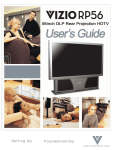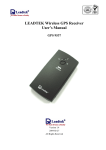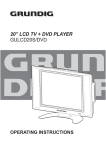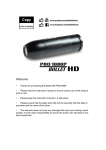Download Vivitek RP56HD21-A User's Manual
Transcript
Contents Introducing Your Micro Chip Display Projection TV.......... 1 Features.................................................................................................... 2 Important Safeguards ................................................................................ 3 Package Contents..................................................................................... 5 Accessories .............................................................................................. 7 Turning on the Main Power........................................................................ 8 Front Controls ........................................................................................... 9 Back Connections ................................................................................... 11 Side Connections ....................................................................................12 Connecting Components........................................................................13 Understanding Video Connections ..........................................................14 Connecting your DVD Player...................................................................15 Using Component Video..................................................................15 Using S-Video .................................................................................16 Using DVI Video ..............................................................................17 Using Composite Video ...................................................................18 Connecting your HDTV Set-Top Box .......................................................19 Using Component Video..................................................................19 Using DVI Video ..............................................................................20 Using RGB Video ............................................................................21 Connecting your VCR or Video Camera ..................................................22 Using S-Video .................................................................................22 Using Composite Video ...................................................................23 Using Coaxial (RF) ..........................................................................24 Connecting off-air TV or Cable TV ...........................................................25 Connecting External Amplified Speakers .................................................26 Connecting an External Receiver or Amplifier ..........................................27 Connecting a Computer ..........................................................................28 Using DVI Video ..............................................................................28 Using RGB Video ............................................................................29 i Adjusting Your Micro Chip Display Projection TV Settings............30 Using the OSD ........................................................................................31 OSD Menu and Options ..........................................................................32 Maintenance and Troubleshooting.......................................................38 Cleaning and Maintenance......................................................................39 Introducing Your Micro Chip Display Projection TV This chapter provides basic information about Your Chip Display Projection TV. Read this chapter to learn about : Features Warnings and Safeguards Package Contents Controls and Connections Micro Features A bright, flicker-free image Automatic detection and conversion of film content for correct display With minimal motion artifacts (noise) Accurate color processing Two high-definition component video input sources that automatically synchronize the display to match the incoming source Picture-in-picture (PIP) modes that let you watch multiple programs simultaneously HDTV signal compatibility using an external HDTV decoder with DVI, RGB or component video outputs HDCP support for video protection Digital zoom mode to get rid of “black bars” around the display image A built-in BBE® sound processor that maximizes the sound quality ® A built-in SRS sound processor that simulates “surround” effects using only two speakers Selectable fixed/variable audio outputs Built-in internal amplifier and speakers A built-in Digital Visual Interface (DVI) to eliminate the need for digital-to-analog conversion 1024 x 768 XGA support for computer input 480i, 480p, 720p and 1080i support for HDTV signals Important Safeguards Warning Risk of electric shock – Do not open this RPTV To reduce the risk of electric shock, do not remove the back cover. There are no user-serviceable parts inside. Removing the back cover voids the warranty. Have your Micro Chip Display Projection TV repaired by qualified service personnel only. Warnings and precautions Do not place your hands, face, or objects close to the ventilation openings of your Micro Chip Display Projection TV. Disconnect all cables before moving your Micro Chip Display Projection TV. Moving your Micro Chip Display Projection TV with its cables attached may damage the cables and cause fire or electric shock danger. Do not expose your Micro Chip Display Projection TV to rain or moisture. Keep your Micro Chip Display Projection TV away from excessive dust, high temperatures, moisture or direct sunlight. Use your Micro Chip Display Projection TV in a well-ventilated area and do not cover the ventilation openings. Do not modify your Micro Chip Display Projection TV or use an unshielded power cord or video input source cable, or you may experience excessive interference. Disconnect your Micro Chip Display Projection TV and unplug the power cord when not used for a long period of time. If the picture displayed is in any way abnormal, turn off your Micro Chip Display Projection TV, then disconnect it from the electrical outlet. Make sure that your video input source cable is connected correctly, then reconnect your Micro Chip Display Projection TV to the electrical outlet. Disconnect your Micro Chip Display Projection TV from the electrical outlet before cleaning or performing maintenance. Do not use liquid or aerosol cleaners. Use only a slightly damp cloth for cleaning. Do not place your Micro Chip Display Projection TV on an unstable cart, stand, or table. Your Micro Chip Display Projection TV may fall, causing serious damage. Do not place your Micro Chip Display Projection TV on a bed, sofa, rug, or other similar surfaces. Never place your Micro Chip Display Projection TV near or over a radiator or heat source. Do not install your Micro Chip Display Projection TV in an enclosed area unless correct ventilation is provided. Your Micro Chip Display Projection TV should be operated from the type of power source indicated on the label. If the type of available power is unknown, consult your electrician or local power company. Your Micro Chip Display Projection TV is equipped with a 3-pin grounded plug. The plug will only fit into a grounded power outlet. This is a safety feature. If you cannot plug the power cord into the outlet, contact your electrician. Do not alter the plug becausf4 Te01ug bel15(any)85(. )]T/C2_ J 0 1 180477 T66 Tc 0 Tw Power cord User guide Accessories You can purchase these optional accessories for your Micro Chip Display Projection TV : Filters Lamps Contact for these and other accessories. Turning on the Main Power To turn on the power : 1 Connect the power cord to the power cord connector on the back of Your Micro Chip Display Projection TV, then plug the other end of the power cord into a correctly grounded electrical outlet or surge protector. 2 Press the POWER button on the front of your Micro Chip Display Projection TV. The Status LED on the front turns blue. Warning For added protection during a lightning storm or when it is left unattended or unused for long periods of time, unplug your Micro Chip Display Projection TV from the wall outlet and disconnect the antenna or cable system. Front Controls Input LED Remote OK Control Power Lamp Status Volume Sensor MENU and Adjust Power LED Channel and Adjust Button Description Remote control sensor Receives signals from the remote control. Do not block. Volume +/- and Adjustment Z and Y Increases or decreases the volume. OSD active: Adjusts on-screen display (OSD) options. For more information, see “Using the OSD” on page 31. Channel +/- and Changes the channel. Adjustment V and U OSD active : Selects OSD options. For more information, See “Using the OSD” on page 31. OK Opens menus in the OSD. For more information, see “Using the OSD” on page 31. MENU / EXIT Opens / Closes menus in the OSD. For more information, see “Using the OSD” on page 31. Input Switches between available input sources. Power Press once to turn your RPTV on. Press twice to turn you RPTV off. When you turn Micro Chip Display Projection TV off, wait two minutes before pressing this button again. Power LED Displays the power status of your RPTV. For more information, see “Status LEDs” on page 43. Lamp LED Displays the lamp status of your RPTV. For more information, see “Status LEDs” on page 43. Back Connections S-Video In (AV1, AV2) DVI In Audio Out TV/Cable In Composite AV In (AV1, AV2) Component AV In (COMP1, COMP2) RGB In RGB Audio In DVI Audio In Connector Description S-Video Connects to an S-Video device, such as a satellite dish receiver or digital cable box. Audio Out Connects to an external audio device, such as an Audio player. Composite AV In Connects to a composite audio/video device, such as a VCR or DVD player. Component AV In Connects to a component audio/video device, such as a DVD player or set-top box. RGB Audio In Connects to the audio on an RGB device, such as a computer or set-top box. RGB In Connects to an RGB video device, such as a computer or set-top box. DVI Audio In Connects to the audio on a DVI device, such as a computer or set-top box. TV/Cable In Connects to a VHF/UHF antenna or cable TV. DVI In Connects to a DVI video device, such as a computer or set-top box. Side Connections S-VIDEO VIDEO L AUDIO Main R Sub VIDEO IN AUDIO IN Connector Description S-Video Connects to an S-Video device, such as a video camcorder. Video/Audio In Connects to a composite audio/video device, such as a video camcorder or digital camera. Main/Sub MAIN: Plug headphone in here to listen to the audio for the main picture. The built-in speakers are disabled. SUB: Plug headphones in here to listen to the audio for the sub-picture. Video In Connects to an RGB video device, such as a computer. Audio In Connects to the audio on an RGB device, such as a computer. Connecting Components Read this chapter to lean how to connect : DVD Players HDTV decoder set-top boxes VCRs Off-air TV and cable TV External audio devices Computers Warning Before connecting any external components, unplug your Micro Chip Display Projection TV. Understanding Video Connections Your Micro Chip Display Projection TV has four types of standard video connections. You should use the best connection available to get the best display. For example, if your DVD player supports a component video connection, connect the DVD Player to your Micro Chip Display Projection TV using component video instead of composite video or S-Video. Connection Quality Base Cable and Connector Description Coaxial (RF). The video and audio signals are both carried in one cable (the other three connection types only handle video, and require separate connections for sound). Coaxial is the only way to connect an antenna to your RPTV. Good Composite. The video signal is carried through a single “pin.” This connection method is the one that is most commonly found on devices. Better S-Video. The video signal is split into two signals, black-and-white and color. Text displayed on-screen through this connection will be noticeably sharper than composite or coaxial (RF). Best Component. The video signal is split into three signals, two colors, and one black-and-white. Use component video to take advantage of the superior picture provided by signal such sources as HDTV and progressive DVD. Connecting your DVD Player Using Component Video To connect your DVD player using component video : Video Audio 1 Connect the green-colored Y jack on the back of your DVD player to the green-colored Y jack on the back of your RPTV. 2 Connect the red-colored PR or CR jack on the back of your DVD player to the red-colored PR/CR jack on the back of your RPTV. 3 Connect the blue-colored PB or CB jack on the back of your DVD player to the blue-colored PB/CB jack on the back of your RPTV. 4 Connect the red (R) and white (L) audio jacks on the back of your DVD player to the R and L audio-in jacks on the back of your RPTV. 5 Select COMP 1 using the INPUT button on the front of your RPTV. Using S-Video To connect your DVD player using S-Video : Audio Video 1 Connect the S-Video jack on the back of your DVD player to the S-VIDEO jack on the back of your RPTV. 2 Connect the red (R) and white (L) audio jacks on the back of your DVD player to the R and L audio-in jacks on the back of your RPTV. 3 Select AV 2 using the INPUT button on the front of your RPTV. Using DVI Video To connect your DVD player using DVI video : Audio Video 1 Connect the DVI connector on your DVD player to the DVI-In connector on the back of your RPTV. 2 Connect the Audio Out jack on your DVD player to the DVI Audio In jacks on the back of your RPTV. 3 Select DVI using the INPUT button on the front of your RPTV. The DVI port supports High-bandwidth Digital Content Protection (HDCP). HDCP encrypts the transmission between the video source and the digital display for added security and protection. Connecting the Micro Chip Display Projection TV and DVD player by using HDMI/DVI cable can show you the high definition Display. Please refer to page 46~48 as the related resolution supported timing table. Using Composite Video To connect your DVD player using composite video : Audio Video 1 Connect the yellow video jack on the back of your DVD player to the yellow AV 2 IN jack on the back of your RPTV. 2 Connect the red (R) and white (L) audio jacks on the back of your DVD player to the R and L audio-in jacks on the back of your RPTV. 3 Select AV 2 using the INPUT button on the front of your RPTV. Connecting your HDTV Set-Top Box Using Component Video To connect your HDTV decoder set-top box using component video : Video Audio 1 Connect the green Y jack on the back of your HDTV set-top box to the green Y jack on the back of your RPTV. 2 Connect the red PR or CR jack on the back of your HDTV set-top box to the red PR/CR jack on the back of your RPTV. 3 Connect the blue PB or CB jack on the back of your HDTV set-top box to the blue PB/CB jack on the back of your RPTV. 4 Connect the red (R) and white (L) audio jacks on the back of your HDTV set-top box to the R and L audio-in jacks on the back of your RPTV. 5 Select COMP 2 using the INPUT button on the front of your RPTV. Using DVI Video To connect your HDTV decoder set-top box using DVI video : Audio Video 1 Connect the DVI connector on the back of your HDTV set-top box to the DVI-In connector on the back of your RPTV. 2 Connect the Audio Out jack on the back of your HDTV set-top box to the DVI Audio In jacks on the back of your RPTV. 3 Select DVI using the INPUT button on the front of your RPTV. The DVI port supports High-bandwidth Digital Connect Protection (HDCP). HDCP encrypts the transmission between the video source and the digital display for added security and protection. Connecting the Micro Chip Display Projection TV and DVD player by using HDMI/DVI cable can show you the high definition Display. Please refer to page 46~48 as the related resolution supported timing table. Using RGB Video To connect your HDTV decoder set-top box using RGB video : Audio Video 1 Connect the 15-pin D-Sub RGB jack on the back of your HDTV set-top box to the RGB-IN jack on the back of your RPTV. 2 Connect the red (R) and white (L) audio-out jacks on the back of your HDTV set-top box to the R and L audio-in jacks on the back of your RPTV. 3 Select RGB using the INPUT button on the front of your RPTV. After you connect your HDTV set-top box to the RGB input jack on your RPTV, your may need to adjust various RPTV picture settings to correctly match the output from the HDTV set-top box. Please refer to page 46~48 as the related resolution supported timing table. Connecting your VCR or Video Camera Using S-Video To connect your VCR or video camera using S-Video : Audio Video 1 Connect the S-Video jack on the back of your VCR or video camera to the S-VIDEO jack on the back of your RPTV. 2 Connect the red (R) and white (L) audio jacks on the back of your VCR or video camera to the R and L audio-in jacks on the back of your RPTV. 3 Select AV 1 using the INPUT button on the front of your RPTV. Using Composite Video To connect your VCR or video camera using composite video : Audio Video 1 Connect the yellow video jack on the back of your VCR or video camera to the yellow AV 1 IN jack on the back of your RPTV. 2 Connect the red (R) and white (L) audio jacks on the back of your VCR or video camera to the R and L audio-in jacks on the back of your RPTV. 3 Select AV 1 using the INPUT button on the front of your RPTV. Using Coaxial (RF) To connect your VCR using coaxial (RF) audio and video : 1 Connect the “output to TV” (RF out or Antenna out) jack on the back of your VCR to the TV/CABLE IN jack on the back of your RPTV. 2 Select TV using the INPUT button on the front of your RPTV, then go to channel 3 or 4. If you have an off-air antenna or cable box, connect your off-air antenna or cable TV cable to the TV/CABLE IN connector on the back of your VCR. Warning If an outdoor antenna or cable system is connected to your RPTV, make sure that the antenna or cable system is correctly grounded. For more information, see “Television antenna connectors protection (for systems fitted with TV/cable TV tuner cards)” on page 52. Connecting Off-air TV or Cable TV To connect off-air TV or cable TV using coaxial (RF) audio and video : 1 Connect the coaxial (RF) connector from your antenna or cable box to the TV/CABLE IN connector on the back of your RPTV. 2 Select TV using the INPUT button on the front of your RPTV. Warning If an outdoor antenna or cable system is connected to your RPTV, make sure that the antenna or cable system is correctly grounded. For more information, see “Television antenna connectors protection (for systems fitted with TV/cable TV tuner cards)” on page 52. Connecting External Amplified Speakers You can connect your Micro Chip Display Projection TV to a set of external amplified speakers using the AUDIO OUT jacks located on the back of your RPTV. To connect your external amplified speakers : 1 Connect the red (R) and white (L) audio jacks on the back of your speakers to the AUDIO OUT jacks on the back of your RPTV. 2 Set the REAR AUDIO OUTPUT in the OSD to VARIABLE. For information about the OSD, see “Using the OSD” on page 31. Connecting an External Receiver or Amplifier You can connect an external receiver or amplifier to your Micro Chip Display Projection TV. To connect your external receiver or amplifier : 1 Connect the red (R) and white (L) audio jacks on the back of your external amplifier or receiver to the AUDIO OUT jacks on the back of your RPTV. 2 Set the REAR AUDIO OUTPUT in the OSD to VARIABLE if you want to use the volume controls on your RPTV, or FIXED if you want to use the volume controls on your amplifier or receiver. For information about the OSD, see“Using the OSD” on page 31. Connecting a Computer Using DVI Video To connect your computer using DVI video : Audio Video 1 Connect the DVI connector on your computer to the DVI-In connector on the back of your RPTV. 2 Connect the Audio Out jack on your computer to the DVI Audio In jacks on the back of your RPTV. 3 Select DVI using the INPUT button on the front of your RPTV. The DVI port supports High-bandwidth Digital Connect Protection (HDCP). HDCP encrypts the transmission between the video source and the digital display for added security and protection. Connecting the Micro Chip Display Projection TV and DVD player by using HDMI/DVI cable can show you the high definition display. Please refer to page 46~48 as the related resolution supported timing table. Using RGB Video To connect your computer using RGB video : Audio Video 1 Connect the 15-pin D-Sub RGB connector on your computer to the RGB-IN connector on the back of your RPTV. 2 Connect the Audio Out jack on your computer to the RGB Audio In jacks on the back of your RPTV. 3 Select RGB using the INPUT button on the front of your RPTV. Please refer to page 46~48 as the related resolution supported timing table. Adjusting Your Rear Projection TV Settings Read this chapter to learn how to adjust your Micro Chip Display Projection TV settings using the on-screen display (OSD). Using the OSD Your Micro Chip Display Projection TV features an on-screen display (OSD) that lets you adjust and save contrast, brightness, and other settings. Your Micro Chip Display Projection TV saves changes you make to the settings, even if you turn off your TV. To adjust settings from the OSD : 1 Press the MENU button on the front of your RPTV. The MAIN MENU opens. MAIN MENU PICTURE ADJUST PIP SETUP INPUT SETUP TV TUNER SETUP AUDIO ADJUST PARENTAL CONTROLS SPECIAL FEATURES MOVE : SELECT : OK CHANGE: BACK: EXIT 2 Press the ADJUST V or U button on the front of your RPTV to select the menu you want. 3 Press the OK button on the front of your RPTV to open the menu. 4 Press the ADJUST V or U button on the front of your RPTV to select the menu option you want. 5 Press the OK button on the front of your RPTV to open the menu option. 6 Press the ADJUST Y or Z button on the front of your RPTV to adjust the option setting. 7 Press the MENU button on the front of your RPTV repeatedly to exit the OSD. OSD Menu and Options You can use these OSD menu and options to adjust various settings for your Micro Chip Display Projection TV. OSD Menu(PICTURE ADJUST) TV Modes PICTURE ADJUST CONTRAST BRIGHTNESS COLOR TINT SHARPNESS WIDE FORMAT MOVE : SELECT : OK 50% 50% 50% 0 50 STRETCH CHANGE: BACK: EXIT CONTRAST. Adjusts the contrast of the picture. BRIGHTNESS. Adjusts the brightness of the picture. You may need to readjust brightness after the RPTV warms up. COLOR. Adjusts the color saturation making colors more intense. TINT. Adjusts the color of flesh tones. SHARPNESS. Adjusts the amount of detail enhancement. WIDE FORMAT. Adjusts the screen width to STRETCH, CENTER, PANORAMIC, or ZOOM viewing mode. PICTURE ADJUST PC Modes PICTURE ADJUST CONTRAST BRIGHTNESS H POSITION V POSITION AUTO CONFIG ADC CLOCK ADC PHASE WIDE FORMAT MOVE : SELECT: OK 50% 50% 50 50 50 50 STRETCH CHANGE: BACK: EXIT CONTRAST. Adjusts the contrast of the picture. BRIGHTNESS. Adjusts the brightness of the picture. You may need readjust brightness after the RPTV warms up. H POSITION. Adjusts the horizontal screen position. V POSITION. Adjusts the vertical screen position. AUTO CONFIG. Automatically adjusts to the best settings. ADC CLOCK. Removes any vertical distortion and clears or sharpens the displayed characters. ADC PHASE. Removes any horizontal distortion and clears or sharpens the displayed characters. WIDE FORMAT. Adjusts the screen width to STRETCH, CENTER, PANORAMIC, or ZOOM viewing mode. PIP SETUP PIP SETUP PIP STYLE WIDE FORMAT SIZE H POSITION V POSITION TRANSPARANCY MOVE : SELECT: OK MAIN+3 CHANGE: BACK: EXIT PIP STYLE. Turns PIP mode on or off, or choose one of the following pre-set modes: SPLIT. The screen is divided in half. The left side is the main picture and the right side is the sub-picture. POP. The screen is in 16:9 mode and divided in half. The left side is the main picture and the right side is the sub-picture. MAIN+3. The main picture is on the left and there are three small subpictures on the right. MAIN+7. The main picture is on the bottom left and there are four small sub-picture windows across the top and three small sub-pictures on the right. SCAN. The screen is divided into 12 small sub-pictures. When PIP STYLE is set to PIP, the following sub-options are available : WIDE FORMAT. Changes the sub-picture size. Choose between 4:3 and 16:9. SIZE. Changes the size of the sub-picture. H POSITION. Moves the sub-picture left or right. V POSITION. Moves the sub-picture up or down. TRANSPARANCY. Adjusts the sub-picture transparency. INPUT SETUP INPUT SETUP MAIN INPUT DVI TYPE PIP INPUT MOVE : TV TV SELECT : OK CHANGE: BACK: EXIT MAIN INPUT. Selects the video input source for the main picture. DVI TYPE. Selects between VIDEO and COMPUTER devices if the DVI connection is being used. PIP INPUT. Selects the video input source for the sub-picture when PIP is turned on. TV TUNER SETUP TV TUNER SETUP ANTENNA/CABLE AUTO PROGRAM CHANNELS AUTOPROGRAM CHANNELS CHANNEL 24 CLOSED CAPTION CAPTION STYLE NOISE REDUCTION MOVE : SELECT : OK CABLE ADD AUTO CC1 OFF CHANGE: SKIP BACK: EXIT ANTENNA/CABLE. Sets the source for the tuner. Select CABLE (for cable or a satellite dish) or ANTENNA. AUTOPROGRAM CHANNELS. When TV is the selected video input source, your RPTV adds all channels that have a signal to the channel list. CHANNEL. Displays the current TV channel and lets you skip or add the current channel to the channel list. CLOSED CAPTION. Turns closed captioning on and off. AUTO automatically turns captioning on when your LCD TV is muted. CAPTION STYLE. Sets the display style for closed captioning. NOISE REDUCTION. Turns the noise reduction function on or off. AUDIO ADJUST AUDIO ADJUST BASS TREBLE BLANCE TV SOUND INTERNAL SPEAKERS REAR AUDIO OUT SUB HEADPHONE VOL EFFECT MOVE : SELECT : OK 50% 50% 0 STEREO ON FIXED 44% OFF CHANGE: BACK: EXIT BASS. Adjusts the bass. TREBLE. Adjusts the treble. BALANCE. Adjusts the balance level between the channels. TV SOUND. Changes the sound output for TV Programs. Switch between STEREO, SAP(Second Audio Program), or MONO for audio simulcasts. The TV program must support the output option. INTERNAL SPEAKERS. Turns the built-in speakers on or off. REAR AUDIO OUT. Changes the audio output options for the RPTV. FIXED: Bypasses your RPTV’s internal sound controls. VARIABLE: Adjusts the type of output your RPTV sends to the internal speakers or the audio output jack. SUB HEADPHONE VOL. Adjusts the volume to the sub-picture headphones jack. EFFECT. Adds simulated audio effects. Switch between BBE, SRS, VIVAHD3D, EALA, and STEREO. PARENTAL CONTROLS BACK: EXIT ACCESS CODE. A password is required to open the PARENTAL CONTROLS menu. You need the remote control to use this option. SPECIAL FEATURES MOVE : SELECT : OK CHANGE: BACK : EXIT OSD H POSITION. Adjusts the horizontal position of the OSD within the display image. OSD V POSITION. Adjusts the vertical position of the OSD within the display image. OSD TIMEOUT. Specifies the number of seconds the OSD menu is displayed before it turns off automatically. COLOR TEMPERATURE. Adjusts the color temperature to three preset modes. Select COOL, NEUTRAL, or WARM. LANGUAGE. Changes the language of the OSD menu. Select ENGLISH, FRENCH, or SPANISH. SYSTEM INFO. Displays current system information. RESET ALL SETTINGS. Resets all settings, except the parental controls and lamp timer, to the factory defaults. RESET LAMP TIMER. Resets the lamp timer after replacing the projection lamp. SLEEP TIMER. Turns sleep timer on and off and selects the number of minutes the RPTV waits before it automatically turns off. You can specify 30, 60, 90, or 120 Maintenance and Troubleshooting Read this chapter to learn how to maintain and troubleshoot your Micro Chip Display Projection TV. Cleaning and maintenance Status LEDs Troubleshooting Preset Timing Chart & Reference Timing Table Support Notice Cleaning and Maintenance Cleaning the Screen Do not use substances such as glass cleaners, solvents, and thinners. The screen of your RPTV has been specially treated. Wipe the surface gently using only a cleaning cloth or a soft, lint-free cloth. If the surface is particular dirty, use a soft cloth and water to clean the screen. Squirt a little water on the cloth (never directly on the screen), then wipe the screen with the cloth. Warning The screen of your RPTV is made of specially coated plastic and can be scratched or damaged by abrasive or ammonia-based window cleaners. Scratches on the bezel or screen are not covered by your warranty. Do not scratch or hit the surface of the screen with your fingers or any hard objects. Cleaning the Exterior Your Micro Chip Display Projection TV is cooled by air circulated through the vents on the case, so keep the vents free of dust. With your Micro Chip Display Projection TV turned off and unplugged, brush the dust away from the vents with a damp cloth. Be careful not to drip any water into the vents. Do not attempt to clean dust from the inside of your Micro Chip Display Projection TV. Do not use abrasive or solvent cleaners because they can damage the finish on components. Do not allow any excessive water or moisture to come into contact with the surface of your Micro Chip Display Projection TV. If water or moisture gets inside your Micro Chip Display Projection TV, operating problems and electrical and shock hazards may result. Do not scratch or hit the cabinet with your fingers or any hard objects. Do not place articles made from rubber or PVC near the cabinet for any extended periods of time. Replacing the Filter There is a replaceable filter in the back of your Micro Chip Display Projection TV. The filter prevents dust build-up and assures good ventilation for the lamp. Warning Do not operate your Micro Chip Display Projection TV without a filter. Check the filter every six months and replace as necessary to prevent heat damage. To replace the filter : 1 Remove the two filter access panel screws, then remove the access panel. Screws 2 Remove the old filter and insert a new one using the four tabs to hold the filter in place. 3 Replace the filter access panel and secure it with the two screws. Replacing the Lamp You should replace the lamp in the RPTV approximately every 6000 hours to maintain the best possible display image. Do not use a lamp past the rated lamp life. Warning The high-pressure lamp may explode if handled incorrectly. Make sure that your Micro Chip Display Projection TV is turned off, power is disconnected, and the lamp is completely cool (minimum of 45 minutes) before replacing the lamp. To replace the lamp : 1 Turn off your Micro Chip Display Projection TV. 2 Disconnect the power cord and all other external cables. 3 Let the lamp cool completely (approximately 45 minutes). 4 Remove the two lamp access panel screws, then remove the access panel. Screws 5 Remove the two lamp module retaining screws. Screws 6 Use the lamp removal handle to lift the lamp module straight out of the lamp bay. 7 Replace the lamp in the lamp module, then insert the lamp module back into the lamp bay. Caution Make sure that you do not touch the lamp. The oils from your hands can cause the lamp to fail prematurely. 8 Replace the two lamp module retaining screws. Important Make sure that the screws are fastened securely to make sure that the lamp will not shake. Safety discard the used lamp. 9 Replace the lamp bay access panel, then replace the two access panel screws. 10 Connect the power cable and all external cables. Status LEDs There are two status LEDs on the front of your Micro Chip Display Projection TV. Normal Operation State Power LED Lamp LED Description AC off Not lit Not lit AC power not connected Standby mode Orange Not lit AC power is connected and your RPTV is in standby mode. Warm-up Blue Orange Flashing AC power is connected and the power button has just been turned on. Cool down Orange Operation mode Blue Orange Flashing Powering off. Not lit AC power is connected, the power button has been pressed, and the lamp has warmed up. Error Codes Error Code 21 Power LED Flashes blue twice, then orange once. Lamp LED Not lit Description One of the cooling fans has failed. See “Support” on page 49. Lamp trouble or failure. Your RPTV automatically shut down and Flashes blue three 32 times, then orange Flashing twice. restart itself. If this does not solve the problem, see “Support” on page 49. Hardware error. Shut off your Flashes blue five 52 times, then orange twice. RPTV, wait one minute, then Not lit restart your RPTV. If this does not solve the problem, see “Support” on page 49. Troubleshooting Use the following information to solve common problems. You cannot see a picture Make sure that the power cord is plugged into a grounded electrical outlet. Make sure that the power button is turned on. Look in the left air vent to see if the lamp is on. Make sure that the selected input source is connected to a working input source. If your RPTV is connected to your computer in RGB mode, press any key on your keyboard to “wake” your computer. You see a distorted picture or hear unusual sound You may be getting interference from electrical appliances, cars,motorcycles, or fluorescent lights. Try moving your RPTV to another location. The color is abnormal Make sure that the input source cable is connected securely and correctly to the back of your RPTV. The picture has abnormal patterns Make sure that the input source cable is attached securely and correctly to the back of your RPTV. Make sure that the video input source is within the range of your RPTV. Compare the video input source’s specifications with your RPTV specifications. The display image does not cover the entire screen If you are using TV, AV1, AV2, or component with 480i input, use the SCREEN WIDTH or WIDE button on the remote control to scroll through various screen modes. You can see a picture but you cannot hear sound Make sure that the volume is not turned down. Make sure that the sound is not muted. Make sure that the internal speakers are turned on. Make sure that your audio input source cables are connected securely and correctly. The monitor has pixels that are always dark Your RPTV is manufactured using an extremely high level of precision technology. However, sometimes some pixels of your RPTV may not display. Pixel defects within industry specifications are inherent to this type of product and do not constitute a defective product.. You see “noise” or “trash” on the screen When your RPTV’s digital capabilities exceed a digital broadcast signal, the signal is up-converted (increased) to match your RPTV’s display capabilities. Up-converting can cause noise or trash. Screen brightness is diminished Video display devices experience degradation of brightness over the life of the device. Normal brightness degradation is not covered by your warranty. Preset Timing Chart & Reference Timing Table Model no. Model name 1 2 EGA/70 EGA/85 3 4 5 6 7 VGA VGA VGA VGA VESA Horizontal dots 640 640 640 640 640 640 800 Vertical lines 350 350 480 480 480 480 600 Pixel clock (mhz) 25.175 31.5 25.175 31.5 31.50 36 36 Horizontal freq 31.469 37.861 31.469 37.861 37.5 43.269 35.156 (khz) Sync. Polarity + + - - A h.total (us) 31.778 (832) 31.778 832 26.667 23.111 (840) (832) (64) 3.813 40 2.032 1.556 (64) (56) 3.810 2.222 (120) (80) (pixels) (800) B h.sync 3.813 (us)(pixels) C h.back porch (us) (pixels) D h.active (800) (96) 1.907 (96) (96) (48) 25.422 (us) (pixels) (640) E h.front porch (16) 128 (48) (640) 25.422 640 (640) (32) (us) (pixels) Vertical freq (hz) 1.907 0.318 24 (16) 70.087 85.08 59.94 72.809 Sync. Polarity - - - - O v.total (ms) 14.268 (445) 16.684 520 (3) 0.064 (60) 1.048 (lines) (449) P v.sync 0.064 (ms) (lines) (2) Q v.back porch 1.112 (ms) (lines) (60) R v.active (ms) 11.122 (lines) (350) S v.front porch 0.222 (ms) (lines) (525) (37) 0.318 (10) (640) (640) 0.508 1.556 (16) (56) 75 - - 13.333 11.764 (509) 0.069 (3) (3) 28 0.427 0.578 (16) (25) 480 9 + 1024 72 128 800 24 85.008 56.25 (500) (480) (32) 20.317 17.778 0.080 (33) 15.254 - 3 (2) (350) - 12.800 11.093 (480) (480) 0.027 0.023 (1) (1) + 625 2 22 600 1 Model no. Model name 8 9 10 11 12 13 VESA VESA VESA VESA VESA VESA 800x600 800x600 800x600 800x600 1024x768 1024x768 Horizontal dots Vertical lines 800 800 800 800 1024 1024 600 600 600 600 768 768 40.00 50.00 49.500 56.250 65.00 75.00 Horizontal freq (khz) 37.879 48.077 46.875 53.674 48.363 56.476 Pixel clock (mhz) Sync. Polarity + + + + - - 26.400 20.800 21.333 18.631 20.677 17.707 (1056) (1040) (1056) (1048) (1344) (1328) 3.2 2.400 1.616 1.138 2.092 1.813 (us)(pixels) (128) (120) (80) (64) (136) (136) C h.back porch(us) 2.20 1.280 3.232 2.702 2.462 1.920 (pixels) (88) (64) (160) (152) (160) (144) D h.active 20.000 16.000 16.162 14.222 15.754 13.653 (us)(pixels) (800) (800) (800) (800) (1024) (1024) E h.front porch(us) 1.000 1.120 0.323 0.569 0.369 0.320 (40) (56) (16) (32) (24) (24) 60.317 72.188 75.00 85.061 60 70.069 A h.total (us)(pixels) B h.sync (pixels) Vertical freq (hz) Sync. Polarity + + + + - - O v.total (ms)(lines) 16.579 13.853 13.333 11.756 16.666 14.272 (628) (666) (625) (631) (806) (806) P v.sync 0.106 0.125 0.064 0.056 0.124 0.106 (ms)(lines) (4) (6) (3) (3) (6) (6) 0.607 0.478 0.448 0.503 0.600 0.513 (23) (23) (21) (27) (29) (29) R v.active 15.840 12.480 12.800 11.179 15.880 13.599 (ms)(lines) (600) (600) (600) (600) (768) (768) S v.front porch 0.026 0.770 0.021 0.019 0.062 0.053 (1) (37) (1) (1) (3) (3) Q v.back porch (ms) (lines) (ms)(lines) Model no. Model name Horizontal dots Vertical lines 14 15 16 17 18 19 VESA Dos/70 Dos/85 480p 720p 1080i 1024x 720x 720x 720x 1280x 1920x 768 400 400 480 720 1080 1024 720 720 720 1280 1920 768 400 400 480(p) 720(p) 1080(i) Pixel clock (mhz) 78.75 28.327 35.5 27.00 74.25 74.25 Horizontal freq(khz) 60.023 31.468 37.927 31.468 45.00 33.75 - Sync. Polarity A h.total (us)(pixels) + - - - - 16.660 900 936 31.7 22.222 (856) (1648) 108 36 2.37 0.54 (64) (40) 2.07 3.636 (56) (270) (1312) B h.sync (us)(pixels) 1.219 (96) C h.back porch(us) 2.235 (pixels) (176) 54 144 D h.active 13.003 (us)(pixels) (1024) (720) (720) E h.front porch(us) 0.203 18 36 70.077 85.039 (pixels) Vertical freq (hz) Sync. Polarity 26.67 17.24 (720) (1280) 60.0 60.00 (2200) (44) (192) (16) 75.029 30 + + + - O v.total (ms)(lines) 13.328 449 446 16.644 (525) (750) P v.sync 0.050 2 3 0.190 0.111 (6.0) (5.0) 34 42 0.951 0.444 (30) (20) (15) (480) (720) (1080) (800) (ms)(lines) Q v.back porch (ms) (lines) (3) 0.466 (28) R v.active 12.795 (ms)(lines) (768) (400) (400) S v.front porch 0.017 13 1 (ms)(lines) (1) 16.667 5 (562.5) (5.0) Support If this troubleshooting information does not resolve your problem or if you have other questions relating to you Micro Chip Display Projection TV, visit www.vivitek.us You can also call our Service Center at 1-877-603-3582. Safety, Regulatory, and Legal Information A Regulatory compliance statements United States of America Federal Communications Commission (FCC) Unintentional emitter per FCC Part 15 This device has been tested and found to comply with the limits for a Class B digital device, pursuant to Part 15 of the FCC rules. These limits are designed to provide reasonable protection against harmful interference in a residential installation. This equipment generates, uses, and can radio frequency energy and, if not installed and used in accordance with the instructions, may cause harmful interference to radio or television reception. However, there is no guarantee that interference will not occur in a particular installation. If this equipment does cause interference to radio and television reception, with can be determined by turning the equipment off and on, the user is encouraged to try to correct the interference by one more of the following measures : Reorient or relocate the receiving antenna Increase the separation between the equipment and receiver Connect the equipment to an outlet on a different circuit from that to with the receiver is connected Consult the dealer or an experienced radio/TV technician for help. Compliance Accessories: The accessories associated with this equipment are: shielded video cable when an external monitor is connected. These accessories are required to be used in order to ensure compliance with FCC rules. FCC declaration of conformity Responsible party : Vivitek Corp. 48017 Fremont Blvd. Fremont , CA94538 Toll Free : 1-877-603-3582 Product : VIVITEK - RPHD21 RP TV This device complies with Part 15 of the FCC Rules. Operation of this product is subject to the following two conditions: (1) this device may not cause harmful interference, and (2) this device must accept any interference received, including interference that may cause undesired operation. Caution Change or modifications not expressly approved by Vivitek could void the FCC compliance and negate Your authority to operate the product. Canada Industry Canada (IC) Unintentional emitter per ICES-003 This digital apparatus does not exceed the Class B limits for radio noise emissions from digital apparatus as set out in the radio interference regulations of Industry Canada. Le present appareil numérique n´ément pas de bruits radioélectriques dépassant les limites applicables aux appareils numériques de Class B prescrites dans le règlement sur le brouillage radioélectrique édicté par Industrie Canada. Notice All Rights Reserved. Vivitek Corp. 8017 Fremont Blvd. Fremont , CA94538 Toll Free : 1-877-603-3582 All Rights Reserved This publication is protected by copyright and all rights are reserved. No part it may be reproduced or transmitted by any means or in any form, without prior consent in writing from Vivitek. The information in this manual has been carefully checked and is believed to be accurate. However, changes are made periodically. These changes are incorporated in newer publication editions. Vivitek may improve and/or change products described in this publication at any time. Due to continuing system improvements, Vivitek is not responsible for inaccurate information which may appear in this manual. For the latest product updates, consult the Vivitek Web site at www.vivitek.us In no event will Vivitek be liable for direct, indirect, special, exemplary, incidental, or consequential damages resulting from any defect or omission in this manual, even if advised of the possibility of such damages. In the interest of continued product development, Vivitek reserves the right to make improvements in this manual and the products it describes at any time, without notices or obligation. Index A accessories 7 adjust brightness 33 color 33 contrast sound 35 TV settings 33 wide format 27 adjust buttons 32 Adjustment button 10 amplified speakers connecting 26 amplifier connecting 27 antenna connection 11 audio in connection 12 audio in connector 12 audio out connection 11 composite AV in connection 11 composite video 14 connection 11 computer connecting 28 connecting DVI video 28 connecting RGB video 29 connecting amplifier 27 cable TV 25 computer 28 DVD player 15 external amplified speakers 26 external receiver 27 HDTV decoder set-top box 19 off-air TV 25 power cord 8 VCR 22 video camera 22 connections B antenna 11 back panel connections 11 audio and video 12 batteries 5 audio in 12 brightness 33 audio out 11 back panel 11 C component AV in 11 cable kits 7 composite AV in 11 cable TV composite video 11, 12 connecting coaxial (RF) 25 DVI audio in 11 channel button 10 DVI in 11 cleaning 38 PC audio in 11 exterior38 RGB in 11, 12 screen 38 S-Video 11, 12 closed caption 35 contrast 33 Coaxial (RF) video 14 color 33 D component AV in connection 11 DVD player component video 14 connecting component video 15 composite (AV) connecting composite video 18 connection 12 connecting DVI video 17 connecting S-Video 16 O off-air TV audio in connection 11 connecting coaxial (RF) 25 in connection 11 OK button display on-screen display E see OSD external amplified speakers OSD 32 connecting 26 audio adjust menu 35 external receiver brightness 33 connecting 27 closed caption 35 color 33 F contrast 33 features 2 input setup menu 34 filter language 36 replacement kit 7 parental controls menu 36 replacing 39 picture adjust menu 33 front panel buttons 9 PIP mode 34 PIP setup menu 34 H special features menu 36 HDCP 17, 20, 28 timeout 36 HDTV decoder set-top box TV tuner setup menu 35 connecting component video 19 wide format 33 connecting DVI video 20 connecting RGB video 21 P headphone jack 12 PC audio in connection 11 PIP mode 34 I power Input button 10 button 10 LED 10, 43 L power cord 6 Lamp connection 8 LED 10, 43 replacement 7, 40 R LED receiver lamp 10, 43 connecting 27 power 10, 43 remote control 5 status 43 remote control sensor 10 M replacement kits 7 maintenance 37, 38 filter 7 Menu button 10, 32 lamp 7 replacing the filter 39 replacing the lamp 40 DVI RGB in connection 11, 12 S safety 3 Service Center 46 setting up safety precautions 3 status LEDs 43 support 46 S-Video 14 connection 11, 12 T timeout 36 troubleshooting 37, 44 V VCR connecting coaxial (RF) 24 connecting composite video 23 connecting S-Video 22 video camera connecting composite video 23 connecting S-Video 22 video connections types of 14 volume button 10 W wide format 33 NOTE NOTE











































































